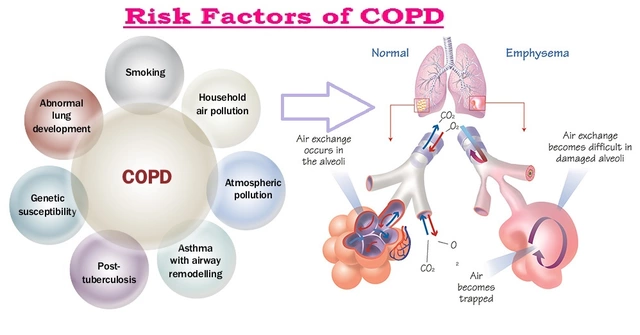
Understanding Chlamydia: A Silent but Serious Infection
Chlamydia is a common sexually transmitted infection (STI) caused by the bacterium Chlamydia trachomatis. It is often referred to as the "silent" infection because many people who have it may not experience any symptoms. However, if left untreated, it can lead to severe health complications, especially for women. As a blogger who aims to educate and inform, I believe it's important to discuss the causes, symptoms, and treatments for Chlamydia in order to help my readers take control of their sexual health and prevent the spread of this infection.
Causes of Chlamydia: How the Infection Spreads
The bacterium Chlamydia trachomatis is responsible for causing Chlamydia infections. It spreads through vaginal, anal, or oral sex with someone who is already infected. This means that anyone who is sexually active can potentially contract the infection. The risk of getting Chlamydia can be higher for those who have multiple sexual partners or those who do not use condoms consistently. It is important to note that Chlamydia can also be transmitted from an infected mother to her baby during childbirth, which can cause health problems for the newborn.
Recognizing Chlamydia Symptoms: What to Look Out For
One of the main reasons Chlamydia is often referred to as a "silent" infection is because a large percentage of people who have it do not experience any symptoms. It is estimated that around 70% of women and 50% of men with the infection do not show any signs. However, when symptoms do occur, they can be quite varied and may include:
For Women:
- Painful urination
- Abnormal vaginal discharge
- Pain during sex
- Lower abdominal pain
- Bleeding between periods or after sex
For Men:
- Painful urination
- Discharge from the penis
- Swelling or pain in the testicles
If you or your partner experience any of these symptoms, it is essential to see a healthcare professional for testing and diagnosis.
Diagnosing Chlamydia: The Importance of Testing
Given that many people with Chlamydia do not display any symptoms, it is crucial to get tested regularly if you are sexually active. This is particularly important for women under the age of 25, as they are at a higher risk of infection. Testing for Chlamydia is simple and usually involves providing a urine sample or a swab from the infected area (such as the vagina, cervix, or urethra).
It is also important to remember that if you test positive for Chlamydia, you should inform all of your recent sexual partners so that they can get tested and treated as well. This helps to prevent the infection from spreading further and causing more health complications.
Treating Chlamydia: Antibiotics to the Rescue
Fortunately, Chlamydia can be easily treated with antibiotics. The most common treatment involves taking a single dose of Azithromycin or a week-long course of Doxycycline. It is essential to complete the entire course of antibiotics as prescribed by your healthcare professional, even if your symptoms disappear before the end of the treatment. Failure to complete the prescribed treatment can result in the infection persisting or even returning.
During the treatment period, it is important to abstain from sexual activity to prevent the spread of the infection to your partner(s). It is also recommended to get retested for Chlamydia around three months after completing treatment, as there is a risk of reinfection.
Preventing Chlamydia: Protecting Yourself and Your Partner
The best way to prevent Chlamydia and other STIs is by practicing safe sex. This includes using condoms consistently and correctly during all forms of sexual activity, including vaginal, anal, and oral sex. It is also vital to communicate openly with your partner(s) about your sexual history and STI status in order to make informed decisions together about your sexual health.
Additionally, getting regularly tested for Chlamydia and other STIs is an important part of maintaining your sexual health. By staying informed and taking the necessary precautions, you can protect yourself and your partner(s) from the potential complications associated with Chlamydia and other sexually transmitted infections.





Josie McManus
June 3, 2023 AT 00:10I totally get how scary it can feel when you realize you might have chlamydia. It’s easy to ignore the signs, especially when they’re so subtle or you think you’re invincible. Getting tested early can save you a lot of heartache and complications later on. If you’re nervous, remember that clinics are used to this and it’s a quick urine test or swab. And if you do test positive, finishing the full course of antibiotics is a must, even if you feel fine. You deserve peace of mind and a healthy future.
Heather Kennedy
June 3, 2023 AT 18:10Screening protocols for chlamydia are well‑established and highly effective for asymptomatic carriers. Routine nucleic acid amplification testing (NAAT) remains the gold standard due to its high sensitivity and specificity. Incorporating periodic testing into sexual health check‑ups can dramatically reduce transmission rates. It’s also crucial to educate partners about the importance of retesting post‑treatment.
Janice Rodrigiez
June 4, 2023 AT 15:00Chlamydia can be a stealthy foe but a quick test can blast it away. Antibiotics are like bright fireworks, clearing the infection in no time. Stay safe and get tested.
Roger Cardoso
June 5, 2023 AT 13:13It’s amusing how the mainstream narrative pushes chlamydia as merely a private health issue while conveniently ignoring the larger sociopolitical framework that underpins its spread.
One must consider the covert influence of pharmaceutical conglomerates that profit from the perpetual cycle of diagnosis and prescription.
These entities have a vested interest in keeping the population dependent on antibiotics, ensuring a steady revenue stream.
Meanwhile, comprehensive sexual education-truly the antidote to epidemic‑level infection rates-is systematically underfunded in public schools.
Delve deeper, and you’ll notice a pattern: the same agencies that champion vaccine initiatives also promote a lax approach to STI prevention, redirecting public scrutiny away from their own agenda.
Furthermore, the data sets released by health ministries are often cherry‑picked, obfuscating the true prevalence of resistant strains emerging from over‑prescription.
It’s not a coincidence that the rise of antibiotic‑resistant chlamydia coincides with the aggressive marketing campaigns of certain drug manufacturers.
Our health infrastructure is riddled with conflicts of interest, and the patient’s autonomy is relegated to a bureaucratic afterthought.
Even the language used in public health flyers is deliberately vague-terms like “regular testing” are ambiguous and lack actionable specifics.
This vague diction serves to maintain a veneer of responsibility while actually discouraging proactive health behaviors.
In an age where data transparency is heralded as a virtue, the suppression of granular infection statistics is a troubling reality.
One could argue that the suppression is a protective measure, preserving national morale, but it also conveniently shields the very entities that stand to profit.
Ultimately, circumventing these hidden forces requires a grassroots push for unfiltered information, community‑driven testing, and an unapologetic demand for accountability.
Only then can we hope to dismantle the covert machinery that perpetuates the chlamydia epidemic under the guise of benign public health policy.
barry conpoes
June 6, 2023 AT 11:26We need to stop letting foreign health agencies dictate our STI guidelines.